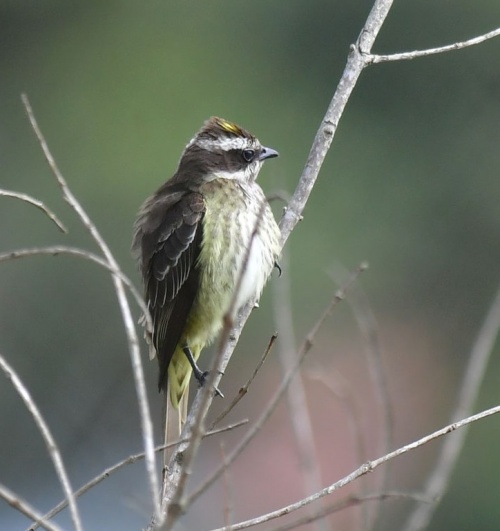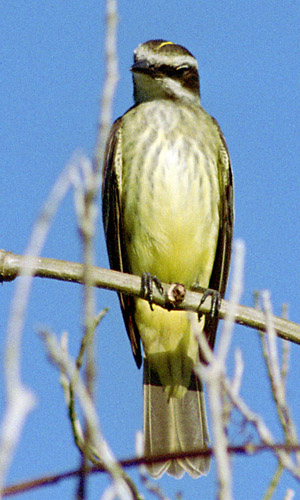- Legatus leucophaius
Identification
14·5–17 cm (5¾-6¾ in)
Olive-brown above, long white supercilium, whitish malar bordered by a thin dark streak below.
The bill is short, plain wings with pale edges to the feathers, white throat while the breast has indistinct dark streaks above the pale yellow of the belly.
Similar species
Various species of "streaked" flycatchers look like this. These include: Variegated, some species in the genus Myiodynastes (Streaked, Sulphur-bellied etc), and possibly "Kiskadee-pattern" species like Social Flycatcher. See also identifying similar species.
Distribution
Two subspecies share the range from Mexico and Trinidad and Tobago to Bolivia and northern Argentina.
This species is rarely noticed during non-breeding season in Trinidad; it is not completely certain whether this is due to migration or inconspicous behavior. Southernmost populations do migrate north in local winter (e.g., Argentina)
Taxonomy
Subspecies
Two subspecies are recognized[1]:
- L. l. variegatus:
- L. l. leucophaius:
Habitat
Borders of humid forests and woodlands, and single trees in clearings, mostly in relative lowland.
Behaviour
Breeding
It gets its name because it uses the nest another species has prepared; as soon as the nest is finished it starts harassing the original owners, until they give up. ffrench (Birds of Trinidad and Tobago) mentions 9 different genera as hosts; all build domed or enclosed nests. Apparently, Crested Oropendola is the most important species in Trinidad.
Diet
Their diet consists of insects such as dragonflies and fruit. It is thought the adults are almost entirely frugivorous.
References
- Clements, J. F., T. S. Schulenberg, M. J. Iliff, D. Roberson, T. A. Fredericks, B. L. Sullivan, and C. L. Wood. 2018. The eBird/Clements checklist of birds of the world: v2018. Downloaded from http://www.birds.cornell.edu/clementschecklist/download/
- Handbook of the Birds of the World Alive (retrieved Sept 2018)
Recommended Citation
- BirdForum Opus contributors. (2025) Piratic Flycatcher. In: BirdForum, the forum for wild birds and birding. Retrieved 10 May 2025 from https://www.birdforum.net/opus/Piratic_Flycatcher
External Links
GSearch checked for 2020 platform.1





